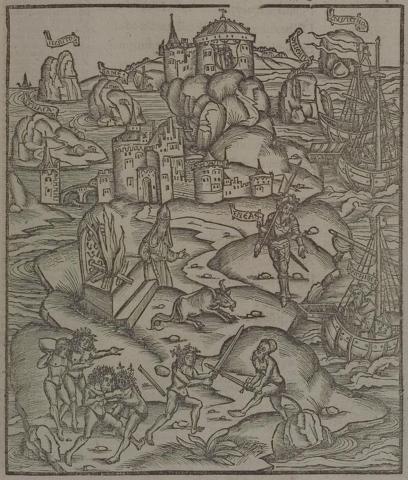Annotations
In the background are Zacynthos, Dulichium, Same, Neritus, and Ithaca, islands which Aeneas passes before he lands. He has landed at Mount Leucates near the shrine of Apollo, which Vergil claims is near Actium (274-5, 279-80), though they are not close to each other. Page suggests that this is a way to associate the games that Aeneas puts on here with the traditional games at Actium (1967, ad 280). In the lower half of the image are the games and sacrificing (278-83). A priest stands between an altar and a dying bull, and pairs of athletes are shown wrestling, swordfighting and throwing either a shotput or a discus. On the right, Anchises, already in a ship, urges Aeneas to gather his men and continue on toward the final destination (289-90). (Katy Purington)
Woodcut illustration from the “Strasbourg Vergil,” edited by Sebastian Brant: Publii Virgilii Maronis Opera cum quinque vulgatis commentariis expolitissimisque figuris atque imaginibus nuper per Sebastianum Brant superadditis (Strasbourg: Johannis Grieninger, 1502), fol. 194r, executed by an anonymous engraver under the direction of Brant.


Sebastian Brant (1458–1521) was a humanist scholar of many competencies. Trained in classics and law at the University of Basel, Brant later lectured in jurisprudence there and practiced law in his native city of Strasbourg. While his satirical poem Das Narrenschiff won him considerable standing as a writer, his role in the transmission of Virgil to the Renaissance was at least as important. In 1502 he and Strasbourg printer Johannes Grüninger produced a major edition of Virgil’s works, along with Donatus’ Life and the commentaries of Servius, Landino, and Calderini, with more than two hundred woodcut illustrations. (Annabel Patterson)